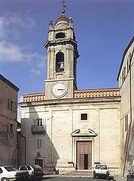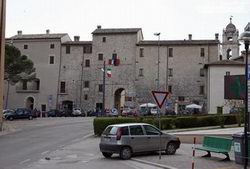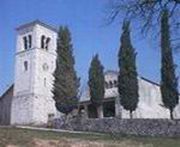Todi's country
Massa Martana
Some
occasional discoveries of lithic tools in different areas of the territory
of Massa Martana, and the existence of prehistorically, fortified villages
("castellieri") on the top of Monte Cerchio and Monte Schignano
seem to indicate the presence of human beings in the territory since the
most remote past.



Massa Martana
La presenza dell'uomo nel territorio martano fin dalle epoche più remote è indicata da alcuni sporadici ritrovamenti di utensili litici in diverse zone e dall'esistenza di castellieri preistorici sulle cime del Monte Cerchio e di Monte Schignano. Cosi come il rinvenimento, in un colle presso la chiesa di Santa Maria della Pace, di cinque tombe a fossa, databili tra l'VIII ed il III secolo a.C., e la presenza, in località Monticastri, di possenti ruderi di mura in opera quadrata indicherebbero l'esistenza di qualche insediamento preromano abitato da popolazioni umbre.La storia di Massa Martana, è legata, in epoca romana, alla costruzione della originaria Via Flaminia, la strada che univa Roma al Mar Adriatico e all'Italia nord-orientale, realizzata intorno al 220 a.C. dal console Caio Flaminio il cui tracciato originario si dirigeva da Narnia (Narni)a Mevania (Bevagna).Nei pressi di Massa Martana, in un luogo a diciotto miglia romane da Narni, localizzabile nel sito dell'attuale chiesa di Santa Maria in Pantano, fu costruita dai romani, probabilmente coeva alla via, la statio ad Martis per la sosta ed il ristoro degli eserciti e dei viaggiatori in transitoIntorno alla statio si sviluppò ben presto un centro abitato: il Vicus Martis, solidamente attestato in molte delle iscrizioni romane qui rinvenute e che ci parlano di molte divinità qui particolarmente venerate come Apollo, Mercurio, Cerere, oltre s'intende a Marte, al quale si deve il nome del Vicus e dell'intero territorio, e del quale doveva esistere nelle vicinanze o addirittura sulla cima dei monti un tempio se è vero che il nome ad Martis significa propriamente ad Fanum Martis, cioè nei pressi del tempio di Marte. Un gran numero di monete degli imperatori Traiano, Adriano, Antonino Pio e Settimio Severo, qui ritrovate e conservate in vari musei dell'Umbria, fanno pensare che sotto quegli imperatori il Vicus Martis godette un periodo di grande floridezza, così come i numerosi colombari, dislocati in luoghi diversi e distanti fra loro, ci fanno pensare ad una forma di insediamento sparso con villae o pagi, facenti capo al Vicus Martis ed intorno ai quali doveva svolgersi una intensa attività agricola. E proprio in una di queste villae, nel cortile dell'abbazia di San Faustino, sono state riportate recentemente alla luce le fondamenta ed alcuni ambienti con suppellettili di lavorazione rustica ed artigianale.Il Cristianesimo vi si diffuse assai presto e vi ebbe un'attiva e numerosa comunità. Lo indicano le leggende agiografiche, seppur tarde, che mettono in relazione con il Vicus Martis un gran numero di santi e martiri.San Brizio e San Felice vengono addirittura ricordati come vescovi della Civitas Martana, della quale, però, non si hanno finora altre e più valide testimonianze per poterne confermare l'importanza e l'esistenza. Pur tuttavia queste leggende non mancano certo di un fondo di verità. Intorno a Massa Martana è possibile ammirare antichissime chiese dedicate a San Felice, ai Santi Fidenzio e Terenzio, a Santa Illuminata, a San Faustino, tutte con cripta e sarcofagi nei quali, da sempre, la devozione popolare venera le tombe dei martiri sopra ricordati. Dopo la caduta dell'Impero Romano la Via Flaminia fu percorsa da orde di barbari e Vicus Martis, l'odierna Massa Martana, fu devastata dai Visigoti di Alarico. La lunga guerra tra eserciti gotici e bizantini trasformò tutto il territorio in un campo di battaglia costringendo gli abitanti a rifugiarsi sulle alture, dando così origine ai primi insediamenti fortificati Le popolazioni scampate alle devastazioni della guerra si rifugiarono sulle alture vicine, più difendibili e sicure, dando origine ai primi insediamenti fortificati intorno ai quali si svilupparono poi i castelli medioevali che costituiscono ancor'oggi i centri abitati di Massa Martana e delle sue frazioni. Ed è proprio all'epoca della dominazione Longobarda che risale l'origine del Castello di Massa,che una ben radicata tradizione vorrebbe invece edificato tra il X e XI secolo dagli Arnolfi, feudatari di un vasto territorio a cavallo dei Monti Martani. Lo stesso nome di Massa, ricorrente con frequenza nei documenti longobardi nel senso di insieme di abitazioni fortificate, fa fede di tale origine. Nel X secolo il territorio di Massa Martana faceva parte del feudo degli Arnolfi ai quali si deve un consolidamento del castello di Massa dove, nel 1094, vi si stabilì un discendente di quella famiglia, Raniero di Bonaccorso che dette origine al ramo Bonaccorsi Fonzi nobili di Massa. Questi fece erigere sulla cima dei Monti Martani una rocca forse identificabile con la Turris montis Martani citata in un documento del 1115 con il quale i conti Ridolfo, Saraceno, Guillelmo, Hugolino, Bulgarello e Tebaldo permutavano alcuni loro possedimenti con l'abate Beraldo di Farfa. Nel 1277 il castello passò sotto il dominio dei Bentivegna e quindi dei possedimenti tuderti.Nel 1305 fu cinta d'assedio dai Ghibellini e salvata solo dall'intervento di Perugia e di Benedetto XI.Nel 1307 papa Bonifacio IX liberò Massa dal dominio tuderte passandola sotto quello della Chiesa, ma nel 1403 ritornò sulle proprie decisioni restituendo il castello e le sue terre al dominio della rivale. Dominio contestato ripetutamente dai massetani nel 1432 e nel 1469. Gelosi delle proprie libertà e tenaci nel conseguire l'agognata indipendenza, i massetani tornarono alla carica nel 1473 rivolgendosi al papa Sisto IV che, in un primo momento, diede ascolto alle loro istanze per deluderli, qualche anno dopo, revocando, come già fece Bonifacio IX, i benefici concessi. Dopo essere stato posto, da Alessandro VI, sotto il governo del Collegio dei Chierici ed aver subito un saccheggio nel 1516, ordinato dal governatore pontificio di Todi per non aver voluto alloggiare alcuni reparti militari della chiesa, il castello di Massa fu ceduto a Todi, nel 1565, dalla Camera Apostolica per 23.000 scudi d'oro. Quello stesso anno, però, i massetani ottennero l'annullamento dell'atto di vendita pagando alla Camera Apostolica un riscatto di 11.000 scudi d'oro e liberandosi finalmente per sempre dalla giurisdizione di Todi. Tale riscatto fu, poi, in parte condonato per l'intervento del pontefice Pio V che fu onorato come compatrono e benefattore. Conquistate così a caro prezzo l'indipendenza e la libertà, per meglio difenderle e tutelarle, i massetani si posero nel 1571 sotto la protezione perpetua del Collegio dei Cardinali e riformarono lo statuto comunale.Tale costituzione, tranne una breve interruzione nel periodo napoleonico quando Massa fu mairie con giurisdizione su di una vasta zona, fu mantenuta in vigore fino al 1860. Con il plebiscito di quello stesso anno anche Massa venne a far parte del Regno d'Italia, assumendo, nel 1863, l'attuale nome di Massa Martana che sintetizza magnificamente le sue origini romane e medioevali.